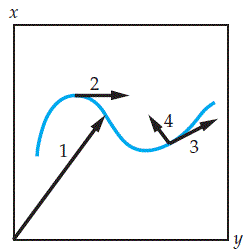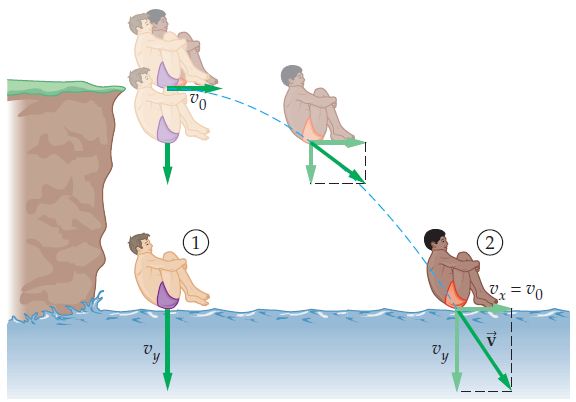Summary
- Freefall
- Vectors
- Vector components
The blue curve displays the constant-speed motion of a particle in the x-y plane.
Which of the vectors shown is an acceleration vector?

A. 1
B. 2 and 3
C. 4
D. 1 and 4
Answer
wk4
Reading quiz Two divers run horizontally off the edge of a low cliff. Diver 2 runs with
twice the speed of diver 1. When the divers hit the water, the horizontal distance covered
by diver 2 is _____ the horizontal distance covered by diver 1.

A. twice as much as
B. four times as much as
C. equal to
Answer
sj6 4.10
A shell is fired at 300 m/s at an upward angle of 55°. It lands on a mountainside 42.0 s after firing. At what elevation above the gun does it land?
A. 1680 m
B. 7230 m
C. 9450 m
D. 10,320 m
Answer
sj6 4.56
A boy can throw a ball a max horizontal distance 40.0 m. How high can he throw the same ball vertically upward? Assume he gives the ball the
same initial speed in each case.
A. 10.0 m
B. 20.0 m
C. 30.0 m
D. 40.0 m
Answer
C. 4

Vector 1 is from the origin and must be a position vector. Also,
its length and direction imply the particle would be slowing down and turning left at the point it
intersects the curve, but the particle has constant speed, so vector 1 cannot be an acceleration vector.
Vectors 2 and 3 are parallel to the motion and must be velocity vectors. Because the speed is
not changing, the acceleration vector cannot point along the direction of motion. Only vector 4 can
be an acceleration vector. Furthermore, its direction implies the particle is turning left,
consistent with the path shown in the diagram.
A. twice as much as
The two divers will fall for the same length of time because they begin
at the same height and with zero vertical velocity. The distance each travels horizontally
before landing is determined by x = v0xt, so the diver
with twice the velocity v0x will travel twice as far horizontally.
A. 1680 m

B. 20.0 m







